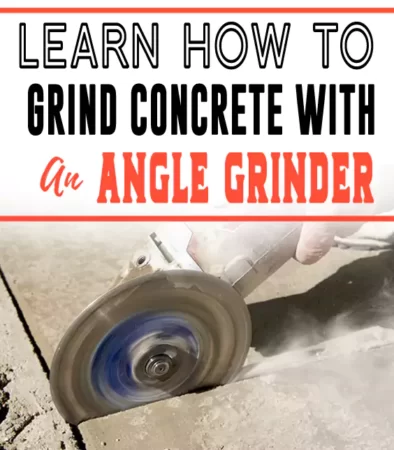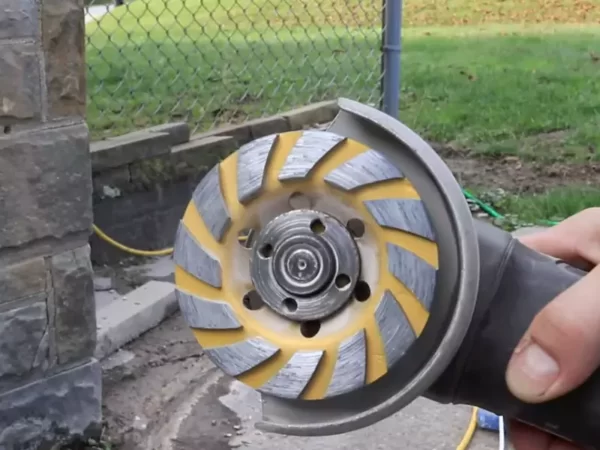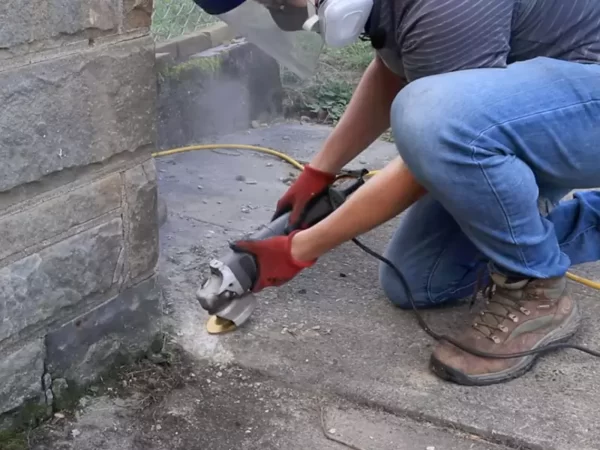With a compact design, lightweight, powerful motors, and high-quality blades, angle grinders are ideal for grinding concrete and cutting Asphalt.
Grinding concrete with an angle grinder is easy to do. They are exceptional tools for construction sites to cut materials and grind concrete with diamond and abrasive blades.
Using this machine to grind concrete saves time and improves productivity with efficiency.

4 Steps to Grind Concrete with an Angle Grinder
Whether you’re a professional or a newbie, get your helmet, leather gloves, and goggles in place for protection against flying debris and unexpected accidents.
Step 1: Clean the Surface
Vacuum cleaner, diamond polishing pads, safety clothes, kneepads, mask, and goggles are required items for a successful concrete grinding project with an angle grinder.
If you have these items available, your first task is to remove any concrete flaking or loose materials away from the surface. It’s time to pick up a broom and sweep the concrete floor to ensure a clean environment.
Note: Remove all debris, including specks of dust, gums, grease, and other dirt on the floor.
Keep in mind that you need to clear the floor for any residue. You can also use a pressure washer or vacuum cleaner for optimal cleansing to prevent unexpected accidents.
If finding a vacuum cleaner or pressure water is a challenge, consider using a scrub and mop to clean the concrete surface. It will be best to wear a kneepad and mask while scrubbing the floor to prevent debris and dust from your nose.
Another ideal cleaning option is the use of a concrete degreaser. Apply gently and scrub with a broom if you want to remove concrete contaminants from the surface with the degreaser.
After clearing the surface, consider re-checking or use a pressure washer to clean the area again.
Step 2: Prepare the Grinder

Now that you have a clean surface, it’s time to focus on the machine. It is advisable to keep your machine in good shape before the grinding operation begins. You can use an angle grinder stand to place the tool safely.
At the same time, the preparation depends on the concrete flow space. Consider dividing it into sectors. It fastens and streamlines the process for optimal results.
Keep in mind grinding produces excessive dust, so putting using the dust shroud and put protective gears in place will save your eyes from debris. It is time to focus on diamond polishing and wheel. Turn the machine off before mounting both tools accordingly.
Note: Before turning on the device, make sure you have an excellent wheel and polishing pad in the correct location.
After putting these factors in place, power the machine by connecting its cord to the electric socket before dividing the floor into sections.
The machine offers more control with unique qualities to finish the project quickly. Furthermore, invest in repairing any gaps or cracks on the concrete surface before swinging into action to prevent unexpected accidents.
In addition, consider the health of the machine before grinding. It will be best to check the machine’s abrasive disc, motor health, and diamond polishing pad before using it for efficient performance.
Step 3: Start Grinding

Grinding is the main delicate part of the operation. While the grinding process is straightforward, you may encounter a few challenges reaching out to corners.
The grind has to be effective with adequate precision. If you want to grind corners successfully, consider using a smaller device and start with the edges.
After grinding the concrete edges, work your way inwards and swing the machine with consistency.
You can decide to swing your angle grinder in different directions, but moving in a circular form is the best way for enhanced performance. It is advisable to run the tool in a way you consider ideal.
After grinding a portion of concrete with your angle grinder, you’ll have a chunk of dust around the perimeter zone.
While the dust shroud plastic is an integral part of the machine, it also prevents the wheel from grinding areas close to the wall, causing a pile of dust.
Solve this problem by removing the dust shroud from the machine and focusing on areas of concern.
Step 4: Fix Imperfections
After grinding the required surface, it’s time to check the results and work on the defects. A careful and thorough evaluation will reveal the loopholes and areas that need smoothening.
Although it requires extra effort and attentiveness, grind the areas of concern again if you want an even floor.
Remember that removing the dust shroud plastic will allow you to grind areas close to the wall. When you have an even floor, it’s time to remove excesses and debris with a vacuum cleaner or mop.
The quality of this exceptional machine when it comes to grinding grind concrete will leave you with a lasting impression.
How to Smooth Concrete with an Angle Grinder

Experience has a part to play when it comes to smoothening concrete with angle grinders. But if you want to know how to smooth the concrete with an angle grinder, follow the below steps:
Step 1: Wear your Safety Gear
Respiratory masks, leather hand gloves, goggles, kneepads, and safety clothes are essential safety tools for your protection. Without adequate protection, you’re vulnerable to common accidents and injuries while smoothening concrete with the machine. Wear the mask, gloves, and goggles before using the device.
Step 2: Clean the Surface
Ensure you have a clean surface before smothering with the tool. Use a damp cloth or vacuum cleaner to clean debris and specks of dust from the surface.
Step 3: Insert the Diamond Disc
After cleaning the surface, fix a diamond disc into the machine for optimal performance. If you want to install the disc, remove the battery and tap the spindle lock on the machine.
It’s time to remove the clamping flange with a wrench. It is a metallic object with the shape of a ring holding the disc in position. Remove the previous disc, clean the area and insert your diamond disc.
Step 4: Turn On the Grinder
Now that you have a diamond disc ideal for the project plug the cord into a socket or fix the battery before starting the machine. Test-run the grinder before working on your project.
Step 5: Start Smoothening
Smoothening concrete with the wet and dry methods ensures optimal results. As their name suggests, water is the only difference between both strategies.
The wet method requires you to pour water on the surface while smoothening, but the case is different for the dry strategy. It does not require water.
Step 6: Clean the Surface
After smoothening the surface, it’s time to pick up a rag to clean the surface.
How to Grind Concrete without Dust
The best way to grind concrete floors with an angle grinder without dust involves using the wet cutting technology cutting system.
You can also grind concrete with this method without overheating the machine. One way to ensure adequate water supply is the use of a water reservoir and hose.
Make sure the water gets into the blades, and if water is scarce, get the necessary help.
You can also wet the surface with a plastic water bottle. It is advisable to prevent water from entering into the machine’s vital parts for effective performance.
If you’re working on multiple-story buildings, do not consider this strategy to avoid flooding the neighbors. While this method eradicates dust, it also increases the blades’ life span and enhances productivity. It converts dust into the sludge to minimize respiratory issues.
The wet cutting technology system is essential for large constructions to rip through concrete. The machine discs can operate for longer hours because the water cools down the pressure resulting from the concrete impact.
With this strategy, the blades operate at an optimal level and can achieve a clean and precise cut without frequent stops. With the use of water instead of gasoline or diesel, this method prevents electrocution dangers.
FAQs
1. Can you Use an Angle Grinder on Concrete?
Yes, you can use the versatile tool on concrete. Angle grinders are unique tools designed to smoothen and grind metallic welds with a rotating blade.
The blade is also ideal for concrete projects. We recommend using a 6-inch angle grinder to grind concrete.
2. Can you Use An Angle Grinder To Level Concrete?
Yes, you can level concrete with the tool. It can smoothen, polish and level concrete. You can also eradicate sticky paints on the floor. It would be best if you vacuumed cleaner to remove debris after leveling.
3. What Grinder Wheel is Best for Concrete?
Smoothening or grinding concrete is a challenge because the surface is tough. But a diamond grinding disc streamlines the process. It is the best grinder wheel ideal for concrete because of its unique qualities.
4. Can you use Metal Grinding Wheel on Concrete?
You can use a metal grinding wheel on concrete because it contains aluminum oxide or zirconia. These blades are harder and sharper than regular blades, making them ideal for masonry or concrete surfaces.
5. How Long Does a Concrete Grinding Disc Last?
You will find the expiry date of the disc, according to manufacturing regulations. But if that’s not the case, check the disc center ring. However, grinding discs usually have a three-year expiry date.
Now that you understand the concepts involved in grinding concrete with angle grinders keep safety precautions in mind. Since the process involves swinging blades and concretes, consider choosing the right strategy for safety reasons.
Consider investing in this efficient and productive tool if you want a machine that can smoothen and grind concrete floors. The outstanding device can handle various projects, including cutting metals.
Grinding concrete with an angle grinder is a challenge for beginners, but you can succeed with practice and attentiveness. Hope this thread will be helpful.
Recent Posts
Many DIY lovers and engineers want to build something cool in their garages. What's cooler than a kit airplane? In this setup, the builder receives parts and puts them together in their own space....
Diamond blades have various uses, from cutting tiles and glass to cutting gems and semiconductor materials. If you’re planning to start a renovation or building project, you’ll need a diamond...
